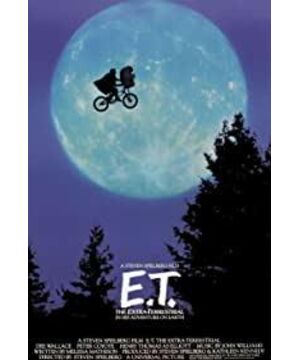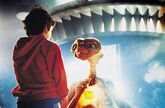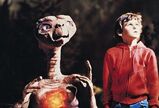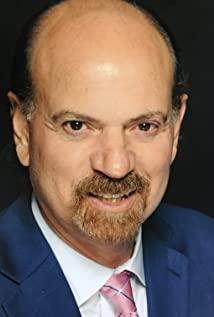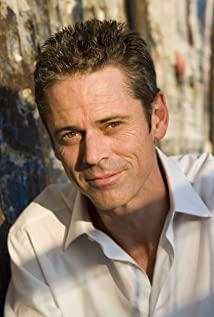Poets did not create poetry
Poetry somewhere behind that
it's been there for a long time
Poets just discover it.
Czech poet Jan Skazel explores the most important and complex problem in the world with childlike simplicity: poetry. Spielberg used a series of shots at the beginning of his sci-fi film "ET" to discover the poetic features and expressions that run through his entire film.
The film begins with a star-filled sky looking up shot, slowly panning from the starry sky to an ordinary wood in the world. The next set of shots shows the alien spaceship and aliens in the woods. The choice of the two sets of shots shows that, combined with the audience's understanding, the events of an alien spacecraft landing on the earth and investigating are perfectly expressed, but the role of this scene is more about the meaning, that is, the story.
Poetry is a combination of fragments of human mood, and it is also an implicit symbol. There is no poetry without symbols.
Immediately following the alien spaceship scene is a series of shots showing humans chasing aliens. In these shots, Spielberg begins to take on the characteristic of his film's poetic character: symbolism.
Poetry is composed of words, and the literary vehicle of its symbolic connotation is the simile, metaphor, and allegory in the words. The poetic nature of the film is made up of performances and shots. As for the poetic quality of the lines, it exists more as a part of the literary quality. As for the poetic nature of the film formed by performances and shots, Spielberg used it perfectly and flexibly in "ET". The symbolism (poetic) of the ET film originates and arises from the following aspects.
1. Lens tone and light and shadow design
Even the night scene, from the point of view of filming, can be shot clearly if the director expects it. Yet, barring the necessary close-ups, Spielberg's background in this shot is deliberately dim and indistinct.
2. Character silhouette (abstract expression)
The film starts at 5 minutes and 43 seconds, and for a long, long time, the images obtained by all the people involved in the chase are either pure silhouettes or substitutes for silhouettes for the audience.
3. Close-up of the waist of the chaser
In the film, the large close-up of the waist of the chaser appears repeatedly, which makes one ponder the meaning behind it. First of all, this is Spielberg's intentional effect, which is to de-characterize characters by showing only their waists. Second, ambush for later manifestation of that particular person (obvious features such as waist keys).
From the above three aspects, we gradually deduce a clear idea, that is, Spielberg wants to convey an idea to the audience. And this idea came out layer by layer with three aspects, intending to show that the power of chasing aliens is now a universal force (adult, hegemony) rather than an individual (all the pursuer images have no personal figurative characteristics, and thus no personal emotional involvement).
Different from the universal power of obsessively chasing aliens, in the first communication between Elliott and ET, Spielberg gave Elliott and ET a large number of and sufficient close-up shots of characters and expressions, emphasizing that personal emotional exchange between the two.
In the over-the-shoulder dialogue of the telephoto lens, Spielberg creates a sense of intimacy with the hero, Elliott and ET, for our audience, in stark contrast to the aloof images of the previous pursuers. This implicitly shows us the preferences and choices of the narrator (director). From a human point of view, the closer we are to us, the more expression we are generally willing to give them. Spielberg is no exception.
As the story progresses, Spielberg continues to use a dichotomy with the chaser's relationship with Elliott and his siblings with ET. In terms of symbolic connotation, it is also a showdown between goodwill and non-goodwill emotions. And starts to reach a small climax at 1:19 of the movie. In terms of time, it conforms to the pattern structure of Hollywood films and is also a twist on the symbolic meaning of film chasers.
Before discussing that, let's talk about ET's most famous shot. This shot is not only Spielberg's response to "ET" being a sci-fi film (after all, sci-fi films must have sci-fi special effects that are different from ordinary films), but also a foreshadowing for the film's final climax.
At 1:20 of the movie, when Elliott's mother first sees ET panic and flee with the child, the chasers have surrounded the Elliott family, and in the most dramatic way (by Elliott's) Riot and their contact with ET) appeared in front of ET.
Ironically, ET died (feigned death) when the mother was holding Elliott, the brother fled with his sister on his back, and the chaser finally contacted and obtained ET in the safe and safe way he was accustomed to. It's a beautiful irony.
It was also at this time that the personal details of the chaser figures (including the man with the waist close-up earlier) were first presented to the audience. In fact, they are not terrible, ET is not terrible, they are afraid because of the prejudice deep in their hearts.
If it weren't for the bicycle flying shot we introduced earlier, then at the climax of the film, when Elliott and his brother and his friends were surrounded by the police, we might have been surprised by the special effects of the flying. However, when we have the previous logical preparation, when they fly, what our audience will get is a knowing smile (the foreshadowing purpose is achieved). The result was a beautiful home run for the fresh forces against the old-fashioned ones.
When the film came here, and when the Mr. Waist came to see ET off with his mother later, we can fully see the purpose and intention of Mr. Spielberg's film. He used the name of science fiction to poetically symbolize how cruel the inexplicable fear and ruthless suppression of new things (represented by ET), the prejudice formed in the human heart over the years, even if their original intentions are for the better.
To sum up the poetic theme of this film in one sentence, then it is: prejudice and time make people gradually conservative, innocence and youth make people accept freshness
View more about E.T. the Extra-Terrestrial reviews


